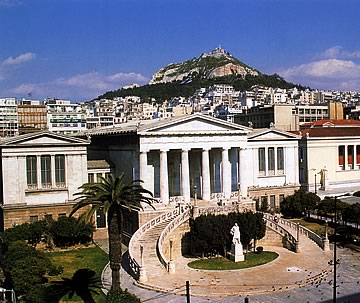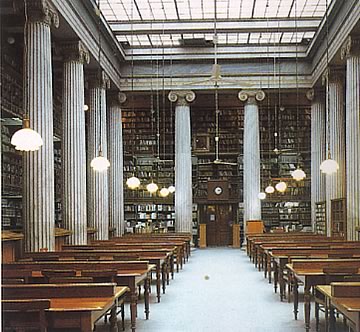
National Library
32 Panepistimiou St, Athens, 1885-1892
Architect
Theophilus von Hansen (1913-1891)
Associate architect
Ernst Ziller (1837-1923)
The National Library is the third building of the
"Athenian Trilogy", the major and highly influential neoclassical
group in the centre of the Greek capital.
The general plan of the Trilogy on Panepistimiou St, that was designed
by Hansen on commission from King Otho in 1859 during Hansen’s
residence in Athens, provided for a monumental building to the left
of the University that would function as a counterweight to the Academy
to its right.
The National Library was funded by the Vallianos brothers. On this building,
Hansen used Ziller’s basic ideas with regard to the main façade,
which was a two-storey building with a large exterior staircase. The
infrastructure was of limestone and upper floor of Pentelic marble.
Owing however to the small size of the lot and its steep slope, the
tripartite articulation of the ground plan was condensed and the building
placed on a foundation that constituted its basement. Thus the height
of the two marble staircases leading up to the elevated porch increased
dramatically, and the stairs with their curved shape, ornate balustrade
and monumental lamps lend the building an eclecticist character.
On the façade of the central wing there is a magnificent hexastyle
porch in the Doric order, designed on the basis of the original on the
Theseion.
The interior of the National Library is the work of Ziller. The vestibule
in the main hall of the reading room has neoclassical polychromy. The
layout of the reading room is characterised by unity and supervisability.
It is lighted by a large skylight in the centre of the ceiling, and
surrounded by an Ionic colonnade with eight columns on the long sides
and four on the short. The metal bookcases in the hall are of particular
construction and stylistic interest.
The subdivision of the main façade into three sections, with
the two lateral buildings being book stacks and the projecting section
of the reading room, lends a feeling of balance to the whole. The lateral
elevations, with the twelve columns of the windows ensuring abundant
natural light, are well articulated, while the administration buildings
at the back are unadorned. The sculptured decoration in the original
design was not finally executed, with the exception of the decoration
of the front pediment by the Viennese sculptor Schwerzek, who was in
Athens at the time to study the Parthenon pediments.
TRANSPORTATION

